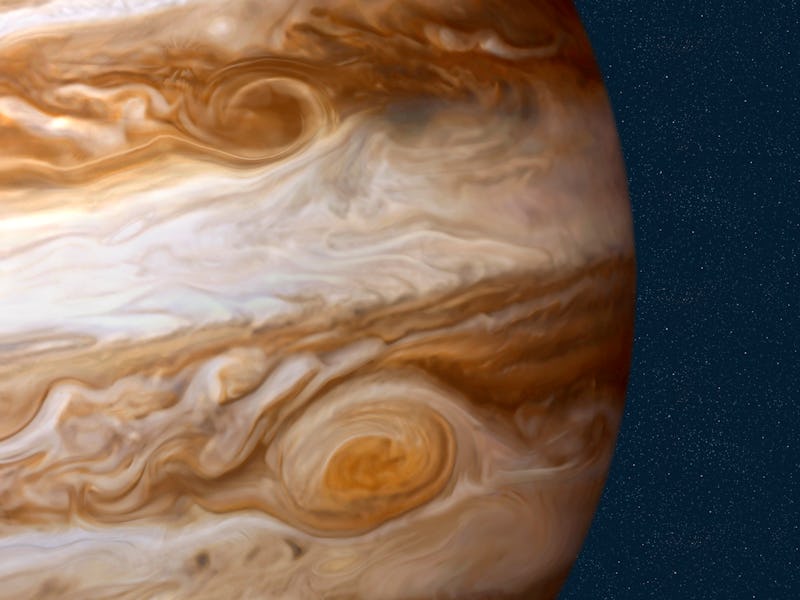The Universe May Be Teeming With Jupiter-Like Gas Giants, New Study Suggests
Recent research suggests that gas giants in the outer reaches of star systems aren't that unusual, in the right kind of stellar neighborhood.

Gas giants like Jupiter may be more common than we thought, at least in some parts of the galaxy.
For a long time, we assumed that our Solar System was the very model of what a star system should look like: a few rocky little planets orbiting moderately close to the Sun, with giants of gas and ice farther out. But we were wrong. Many of the star systems we know of have “hot Jupiters,” gas giants orbiting perilously close to their stars, even closer than Mercury orbits the Sun. It’s rare to find a gas giant like Jupiter in the outer reaches of a star system.
A recent study suggests that that planets like Jupiter may be more common than we thought; they just need quiet neighborhoods to grow up in. That could have interesting implications for the history of our own Solar System.
Raffaele Gratten, of the Italian National Institute for Astrophysics, and his colleagues published their recent study in the journal Nature Communications.
Jupiter, the largest and best planet in our Solar System, orbits at around 5.2 times EArth’s distance from the Sun.
We Are the Weirdos
Gratten and his colleagues carefully studied measurements of the mass and movement of 30 stars in the Beta Pictoris Moving Group, a small group of stars about 115 light years away moving together through space. About 20 of the 30 stars could potentially hold a gas giant about the mass of Jupiter in the outer reaches of their star systems (between 3 and 12 times Earth’s distance from the Sun), according to Gratten and his colleagues.
That’s very different from most of the galaxy, where surveys have found that fewer than one in five Sun-like stars have their own version of Jupiter. A key difference seems to be that the Beta Pictoris Moving Group is small, with plenty of space between its stars, unlike other star-forming areas (and the young stellar neighborhoods they evolve into). In other words, cold, distant gas giants like ours may be more common in small, quiet, less-populated groups of stars than they are in the rest of the galaxy.
“The straight implication of the work is that it is easy to form the Solar System in a quiet environment such as the Beta Pictoris Moving Group,” Gratten tells Inverse.
Gas giants like Jupiter are born in the outer reaches of their star systems, where it’s cold enough for volatile elements to condense easily into balls of ice and gas. Way out there, planets like Jupiter are vulnerable to gravitational nudges, not just from other giant planets but from other stars passing close by. Those nudges can either send the planet wandering inward to become a hot Jupiter or fling it out of the star system altogether.
In other words, solar systems in areas of space with more stars (and less distance between them) may have a hard time forming and keeping their own versions of Jupiter. But Gratten and his colleagues suggest that in less packed, more spread-out stellar neighborhoods like the Beta Pictoris Moving Group, things are quieter, and Jupiters seem to have an easier time forming – and surviving.
This Voyager 1 photo shows Jupiter and 3 of its 4 largest moons.
Where Did Our Sun Grow Up?
Astrophysicists are still debating exactly what our Sun’s birthplace looked like 4.5 billion years ago. We know that the Sun, like all stars, must have formed in a nebula, starting with a dense clump of gas and dust. Gravity caused more material to fall into that dense clump of gas, and eventually, the temperature and pressure at its center were tremendous enough to start fusing hydrogen atoms together into helium.
What’s not clear is whether the nebula that spawned our Sun was a busy stellar nursery, densely packed with newborn stars, or whether it was a quieter, less populated area with just a few young stars scattered across it. The two most popular theories both point to our Sun growing up in a busier neighborhood, either an open cluster of stars like NGC 2244 or a more compact cluster like the nearby Beehive Cluster. But it seems unlikely that our Solar System could emerge from such a large crowd of stars and look the way it does today, with gas and ice giants in the cold outer reaches and a few small, rocky planets with the inner Solar System all to themselves.
“Similar work [to this recent study] on more dense star formation regions would be needed to understand if we can really form the Solar System there,” says Gratten.
More data from the European Space Agency’s Gaia observatory, which orbits the Sun, could shed light on the mystery.
This article was originally published on